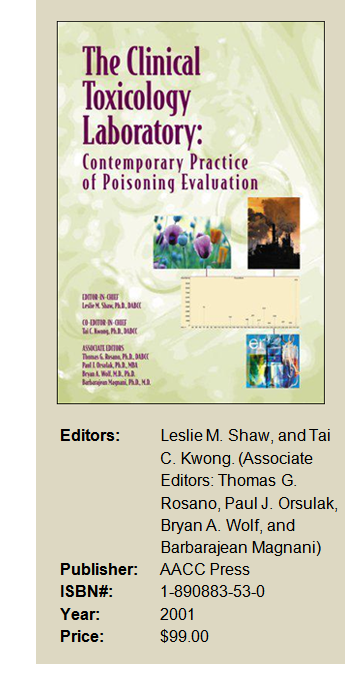 This excellent textbook is based on a clinical toxicology review course which has been offered in the past by the American Association for Clinical Chemistry (AACC) and which has been extremely well received by the participants. The text focuses on the delivery of real time answers to the clinician dealing with the poisoned patient seen in the hospital emergency room setting. The book targets chemists/toxicologists and physicians involved in the delivery of clinical care to the acutely poisoned and chronically poisoned patient. Forensic toxicology with its attendant crime scene investigation is not a subject of the book. The text has 537 pages, 41 contributing authors, 29 chapters, 7 appendices, and 1 index. This excellent textbook is based on a clinical toxicology review course which has been offered in the past by the American Association for Clinical Chemistry (AACC) and which has been extremely well received by the participants. The text focuses on the delivery of real time answers to the clinician dealing with the poisoned patient seen in the hospital emergency room setting. The book targets chemists/toxicologists and physicians involved in the delivery of clinical care to the acutely poisoned and chronically poisoned patient. Forensic toxicology with its attendant crime scene investigation is not a subject of the book. The text has 537 pages, 41 contributing authors, 29 chapters, 7 appendices, and 1 index.
Individual chapters address: 1) the epidemiology of poisoning, 2) toxicokinetics, 3) pharmacokinetics, 4) the clinical presentations and approaches to the diagnosis of the poisoned patient, 5) pharmacogenetics, 6) point-of-care testing methods, 7) samples including urine, blood, plasma, serum and alternative samples (saliva, sweat, hair, meconium), 8) urine adulteration prior to drug and alcohol testing, 9) traditional and advanced analytical techniques, 10) biological monitoring of chemical exposure, 11) a description of the successful toxicology laboratory for different size hospitals, and 12) eighteen chapters on specific toxins.
All of the chapters include learning objectives and a set of self-assessment questions with answers at the back of the book. In addition to these, each chapter on a specific toxin or class of toxins presents the following: a) case studies, b) epidemiology of the toxin, c) chemistry of the toxin, d) nomenclature, e) mechanism of action, f) therapeutic and toxic effects of the toxin, g) pharmacokinetics, h) toxicokinetics, i) methods of analysis with a comparison of their analytical and diagnostic parameters, j) clinical interpretations of concentration data, k) a discussion of current questions and issues relating to the toxin, and l) a list of pertinent references.
There are 7 appendices designed to tabulate in a user-friendly fashion the most important data required in the clinical toxicology setting. Appendix A offers the answers with explanations to the chapter self-assessment questions. Appendix B includes lists of toxins commonly associated with abnormalities of the vital signs (temperature, heart rate, blood pressure, respiratory rate, and papillary responses). Appendix C lists the five most common toxidromes (opioid, sympathomimetic, anticholinergic, cholinergic, sedative hypnotic) and the chemical agents and clinical manifestations associated with them. Appendix D lists the concentrations of drugs and other chemicals that will produce positive results in blood and urine samples for each of the currently commercially available assay methods. Appendix E offers a comparison of test methods for salicylate (aspirin) and acetaminophen (Tylenol®) analysis. Appendix F gives book reviews for 25 selected reference books in the field of toxicology. And Appendix G lists abbreviations used in the book.
This is a superb textbook for both the beginning and advanced student. It should prove useful to clinical chemists, toxicologists, pharmacologists, and clinicians. The learning objectives, case studies, and self-assessment questions add an important dimension to the reader. Of particular note were the efforts to present algorithms by which the physician and the laboratory can use patient history, communication, and clinical presentation to develop a preliminary diagnosis and thus focus the laboratory investigation so as to obtain answers in a timely fashion. Overall, this textbook is an excellent teaching tool for those involved in teaching clinical chemistry, toxicology, and/or clinical medicine. It is highly recommended as the primary text for courses in clinical toxicology.
|
